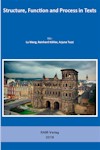 |
Structure, Function and Process in Texts Edited by ISBN: 978-3-942303-56-9 |
Preface
Founded in 1994, the International Quantitative Linguistics Association (IQLA) aims
at promoting the development of theoretical, empirical, and applied Quantitative
Linguistics (QL) and fostering an effective communication among scientists that work
in this highly interdisciplinary field. This multidisciplinary background enables us to
share methods and findings across the boundaries of the individual sub-disciplines,
languages, and methodological areas. Quantitative linguistics cannot only be
characterised as a strongly co-operative science but this property can be considered as
an essential principle.
IQLA organizes on a regular basis the QUAntitative LInguistics COnference
(QUALICO) that represents the most important meeting for IQLA members and for
QL scholars. The first eight conferences in this series took place in: Trier (1991),
Moscow (1994), Helsinki (1997), Prague (2000), Athens, Georgia (2003), Graz
(2009), Belgrade (2012) and Olomouc (2014). The 9th meeting, Qualico2016, took
again place in Trier. The scientific program was organized over 3 days in August 24-
28 in two parallel sessions. The lecture halls were rented in the Deutsche
Richterakademie (German Academy of European Law).
This book includes a selection of the papers presented at Qualico2016 from various
areas of QL. The contributions highlight the richness of this branch of research and the
wide range of different topics, methods and approaches available in QL.
A substantial amount of contributions are focussed on research in morphology.
Klyshinsky, Logacheva and Nivre study morphological ambiguity, aiming at assisting
natural language processing, by defining six types of word ambiguity and computing
their distributions in nine languages. In order to measure grammatical ambiguity,
Wang and Guo introduce polyfunctionality, which refers to the number of parts of
speech a word can be attributed to. They suggest that a universal model can capture the
distributions on data from German, Dutch, English and Chinese. Galieva and
Nevzorova report an attempt to assess the morphological complexity of the Tatar
language. Pawłowski, Topolski, Malak, Kocoń and Marcińczuk compare the
differences between the distributions of vocabulary in the entire corpus and in its
subcorpora (consisting of individual parts of speech), on data from Polish and explain
the reasons. Vulanović and Ruff present a formula, based on set theory, to measure
how much a linguistic system violates the One-Meaning-One-Form principle.
Two contributions to this volume involve stylometrics. Cortelazzo, Nadalutti, Ondelli
and Tuzzi work on an Italian case of authorship attribution and thorough methods of
text clustering investigate the distinctive traits of Elena Ferrante’s writing style with a
specific focus on the presumed similarity with other novels written by Italian authors
from Naples and its surroundings. The study proposed by Sun and Jin on a Japanese
novel Otome no minato, which is published under the name of Yasunari Kawabata but
disputed to be written by Tsuneko Nakazato. This study identifies the authorship by
examining stylometric features such as part-of-speech bi-grams, particle bi-grams and
phrase patterns and classifiers such as correspondence analysis, hierarchical cluster
analysis, etc.
The contribution by Embleton, Uritescu and Wheeler deal with a dialectometric
problem. They test the relationship between the linguistic distance and geographic
distance on data from a Romanian dialect. Their study involves as an innovative
feature, taking the popularity of telecommunication into consideration: The researchers
measure geographic distance by both travel distance and travel time.
Sanada demonstrates a syntactic research on Japanese complement and adjunct. The
quantitative properties of the two sentence components including frequency, length
and position are investigated in various aspects.
Benešová, Faltýnek and Zámečník propose a discussion on functional explanation in
quantitative linguistics, especially in synergetic linguistics. The authors focus on the
philosophic reflection on epistemological and methodological bases and suggest a
reconstruction of the functional model of explanation in synergetic linguistics.
The conference was evaluated both by the organisers and the participants as another
successful event.
The Editors,
Lu Wang, Reinhard Köhler, Arjuna Tuzzi
